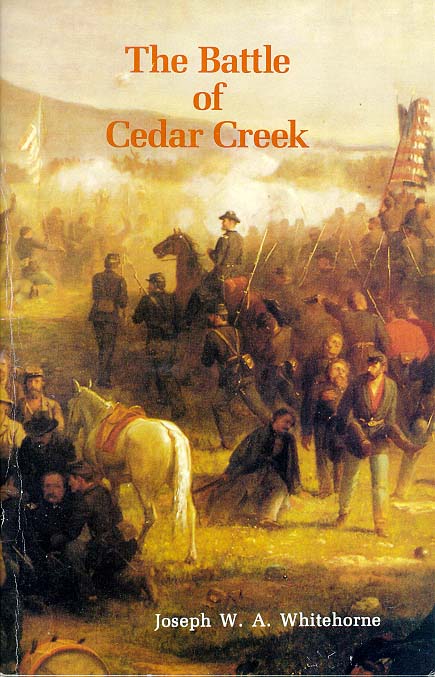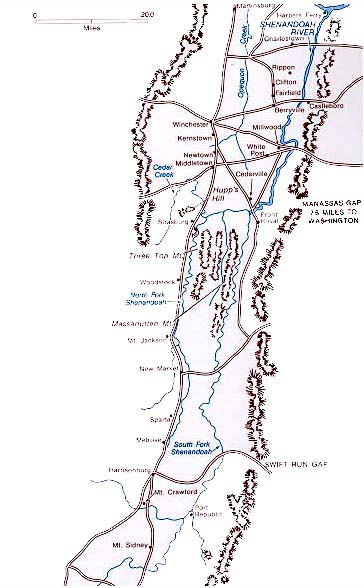


Library of Congress Cataloging-in-Publication Data
Whitehorne, Joseph W.A., 1943-
The Battle of Cedar Creek : self-guided tour / Joseph
W.A. Whitehorne.
p. cm.-(CMH pub ; 70-25)
Includes bibliographical references.
1. Cedar Creek, Battle of, 1864. 2. Shenandoah River Valley (Va. and W. Va.) -Description and travel-Guide books. I. Center of Military History. II. Title. III. Series.
917.55VO443 - dc20 90-25046
CIP
For sale by the Superintendent of Documents, U.S. Government Printing Office, Washington, D.C., 20402
The staff ride has gained popularity in the U.S. Army in recent years as a tool for leader development. By retracing the course of a battle on the actual ground, military leaders and students deepen their knowledge of military operations and gain a better understanding of the vagaries and costs of war that form an important part of military planning.
Staff rides are a particularly appropriate teaching device in a period of prolonged peace when an increasing number of soldiers lack firsthand knowledge of battle. As General Carl E. Vuono, the chief of staff, recently put it, staff rides allow participants "not only to understand the realities of war, but also to improve their professional expertise and the readiness of their units." For these reasons, those of us concerned with military history education are redoubling our efforts to make available suitable materials to support and enrich staff rides.
The Battle of Cedar Creek has long been favored for staff rides. Although scarcely in a class with Antietam and Gettysburg or other greater Civil War clashes, it nevertheless continues to fascinate military analysts because its contained scope readily allows students to grasp important lessons in leadership, tactical planning, and the role of courage and military professionalism under fire. Cedar Creek is also accessible to many major military bases, and I strongly recommend soldiers, either in teacher-directed parties or privately after suitable background reading, to "do" Cedar Creek.
To support such initiatives, the Center is publishing this account of the battle, an updated and expanded reprint of a study originally published by the Wayside Museum of American History and Arts, Strasburg, Virginia. Although rewarding to any armchair scholar, this slim volume should add greatly to the education and enjoyment of any battlefield visitor.
| Washington, D.C.
15 April 1991 |
HAROLD W. NELSON
Brigadier General, USA Chief of Military History |
The last great battle of the Civil War in the Shenandoah Valley of Virginia took place on 19 October 1864 along Cedar Creek between the towns of Strasburg and Middletown. It marked the end of Confederate power in the Valley, and its timing three weeks before the national elections unquestionably influenced the magnitude of President Lincoln's reelection. Despite this significance, the battle has been buried in the legend of Philip H. Sheridan's famous ride from Winchester and the controversy over Jubal Early's lost victory. The land over which the battle raged is still nearly the same as it was in 1864, yet few people visiting it are even aware that a battle took place. This work is intended to introduce the Battle of Cedar Creek to those not yet aware and help those already interested to better understand the history which took place over this quiet farmland.
Since the battlefield area still is largely in private hands, the tour has been designed to be taken by automobile, following public roads. It covers 12 locations important to understanding the essential aspects of the battle, plus 3 optional stops covering specific details. Although an exact chronological sequence is not possible, because of terrain and the complexity of the original events, the stops have been selected to help the visitor see the battle developing. The tour begins at Hupp's Hill on US 11, one mile north of Strasburg and one mile south of the I-81 interchange, and ends at the Lord Fairfax Community College north of Middletown. The complete tour, including optional stops, takes approximately 3-4 hours and covers about 20 miles.
Taking the tour is done at your own risk. Visitors should remain alert to the safety hazards posed by traffic and livestock. Field glasses would be useful at several stops, and the area provides many topics for photographers.
The following "Overview" of the battle should be read before taking the tour. Stops are keyed to the battlefield action described in the "Overview," and it is crucial to have read it before starting the tour. "CR" indicates County Road; "A" indicates optional stop. Names of Confederate personnel appear in italic type; Union personnel appear in regular type. Stop 1A may be visited at the end rather than the beginning of the tour to provide a more accurate tracing of the battle's sequence. Doing so involves additional time and a less convenient route, however.
[NOTE: IN THIS INTERNET EDITION, PAGE NUMBERS HAVE BEEN OMITTED
AND DRIVING INSTRUCTIONS ARE RENDERED IN BOLD-FACED TYPE; PHOTOGRAPHS NOT
INCLUDED IN THE INTERNET EDITION; BIOGRAPHICAL DETAILS ON KEY PERSONALITIES
ORIGINALLY CONTAINED AS CAPTIONS FOR PHOTOGRAPHS ARE NOW CONTAINED IN A
SEPARATE DOCUMENT. LINKS TO COPIES OF OFFICIAL REPORTS FROM THE COMMANDERS
CONCERNED ARE ALSO CONTAINED IN A SEPARATE DOCUMENT.]
| Washington, D.C.
15 April 1991 |
JOSEPH W. A. WHITEHORNE
Lieutenant Colonel (Retired) United States Army |
|
Contents
|
Page
|
| The Valley Campaign | |
| Chronology | |
| Prelude to Battle | |
| Order of Battle | |
| The Battle | |
| Chronology of the Battle | |
| Summary | |
| Suggested Readings | |
|
Self-Guided Tour
|
27
|
|
|
|
|
|
|
|
|
|
|
|
|
|
|
|
|
|
|
|
|
|
|
|
|
|
|
|
|
|
|
|
|
|
|
|
|
|
|
|
|
|
|
|
|
|
| ACKNOWLEDGEMENTS |
|
| PERSONALITIES | N/A |
| Supporting Reports from the Official Records | N/A |
last updated 15 April 2003